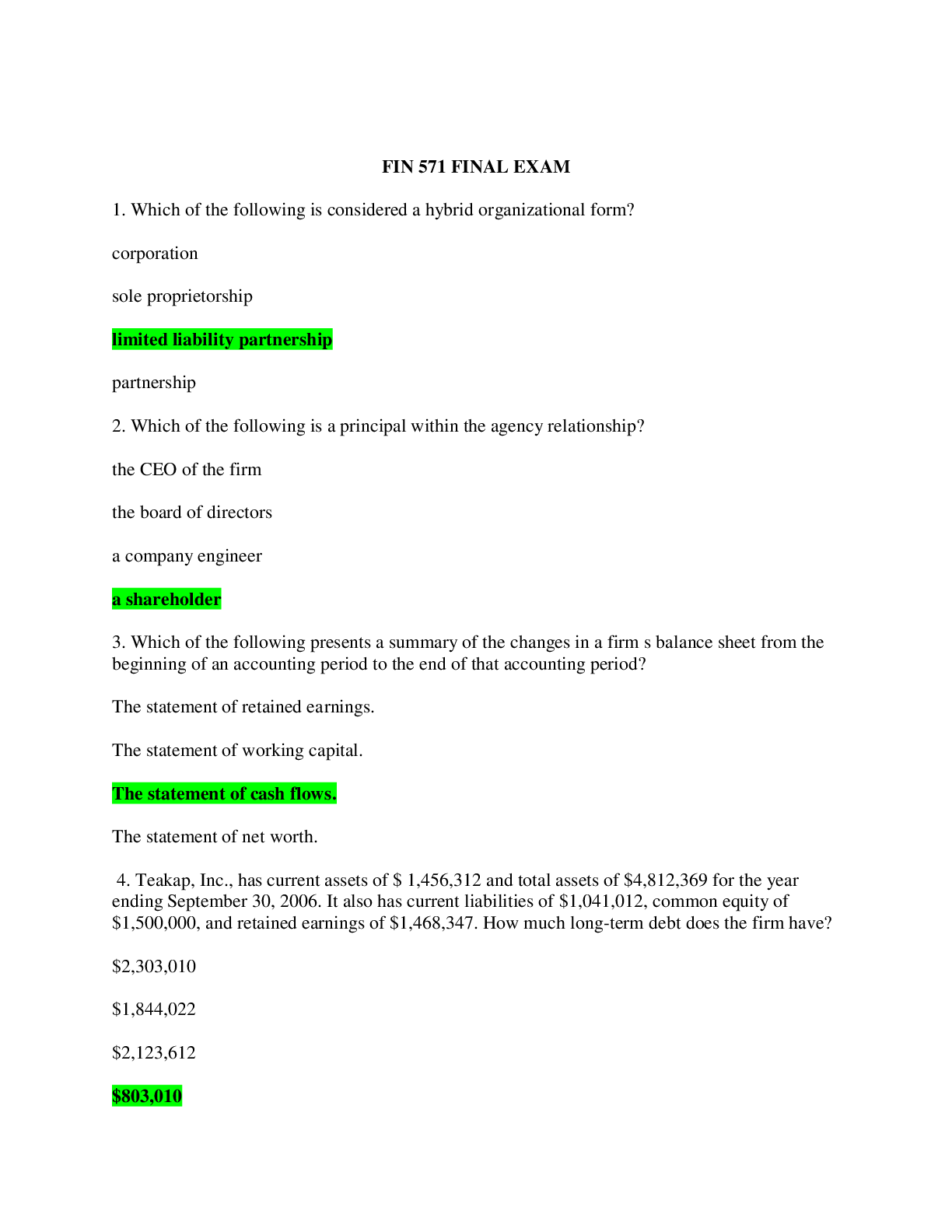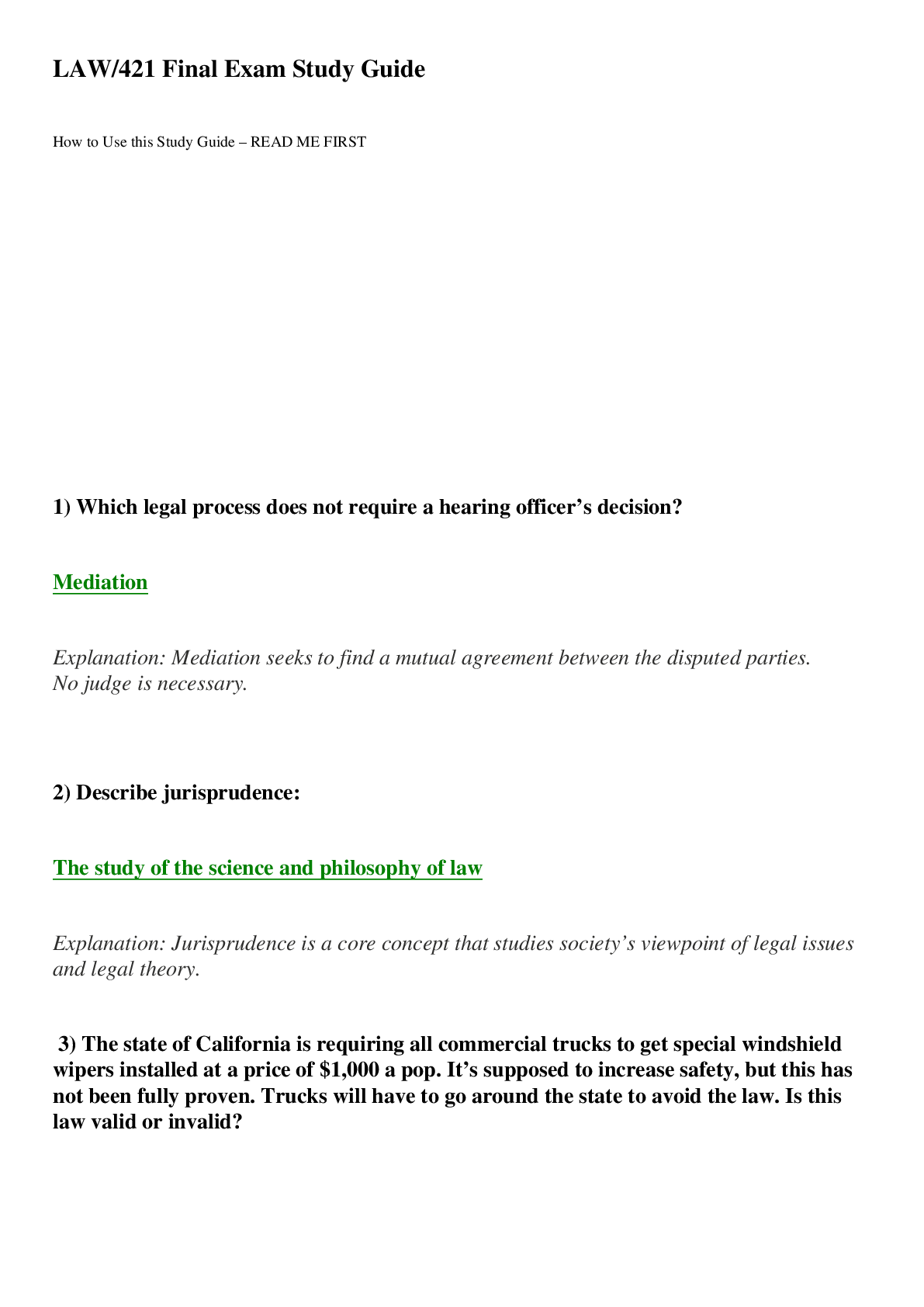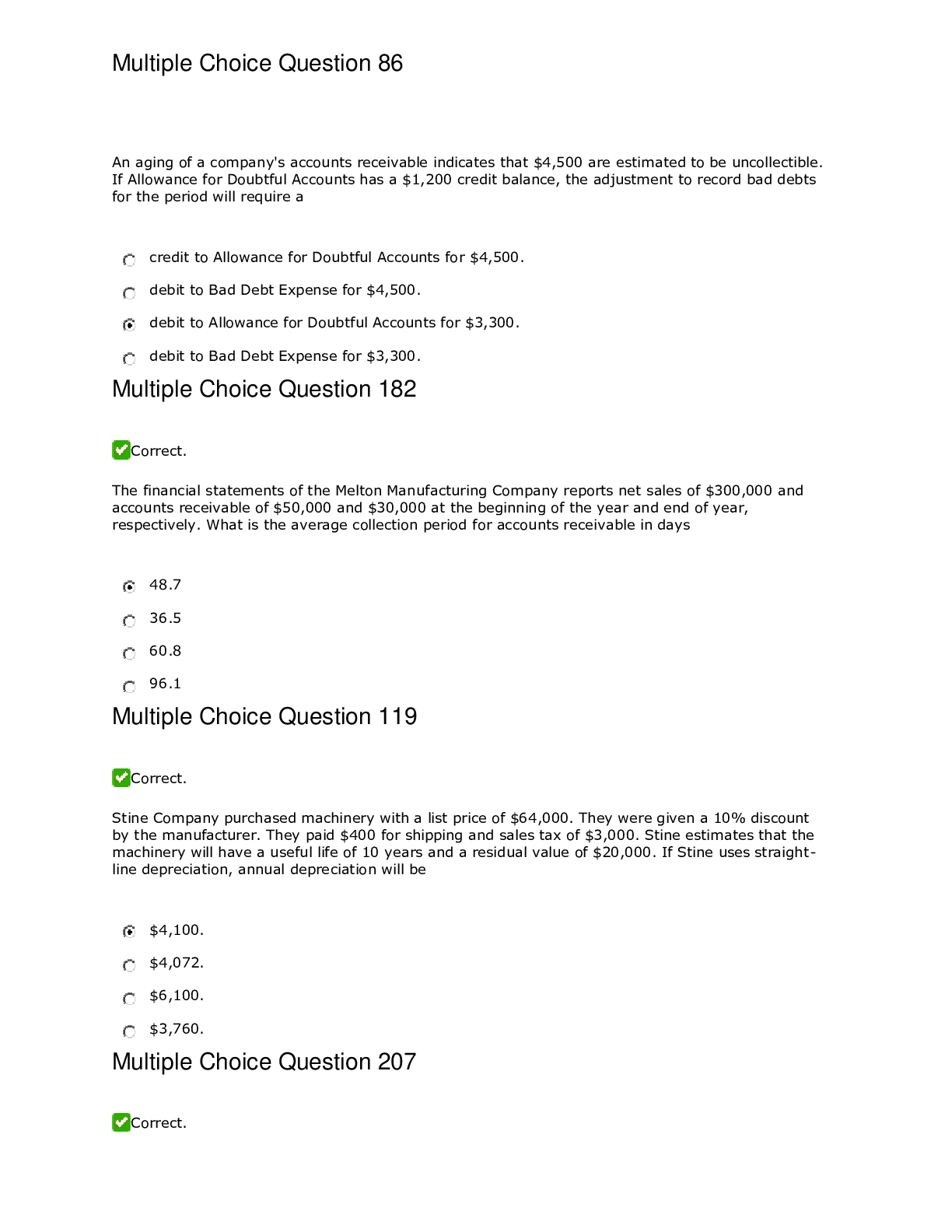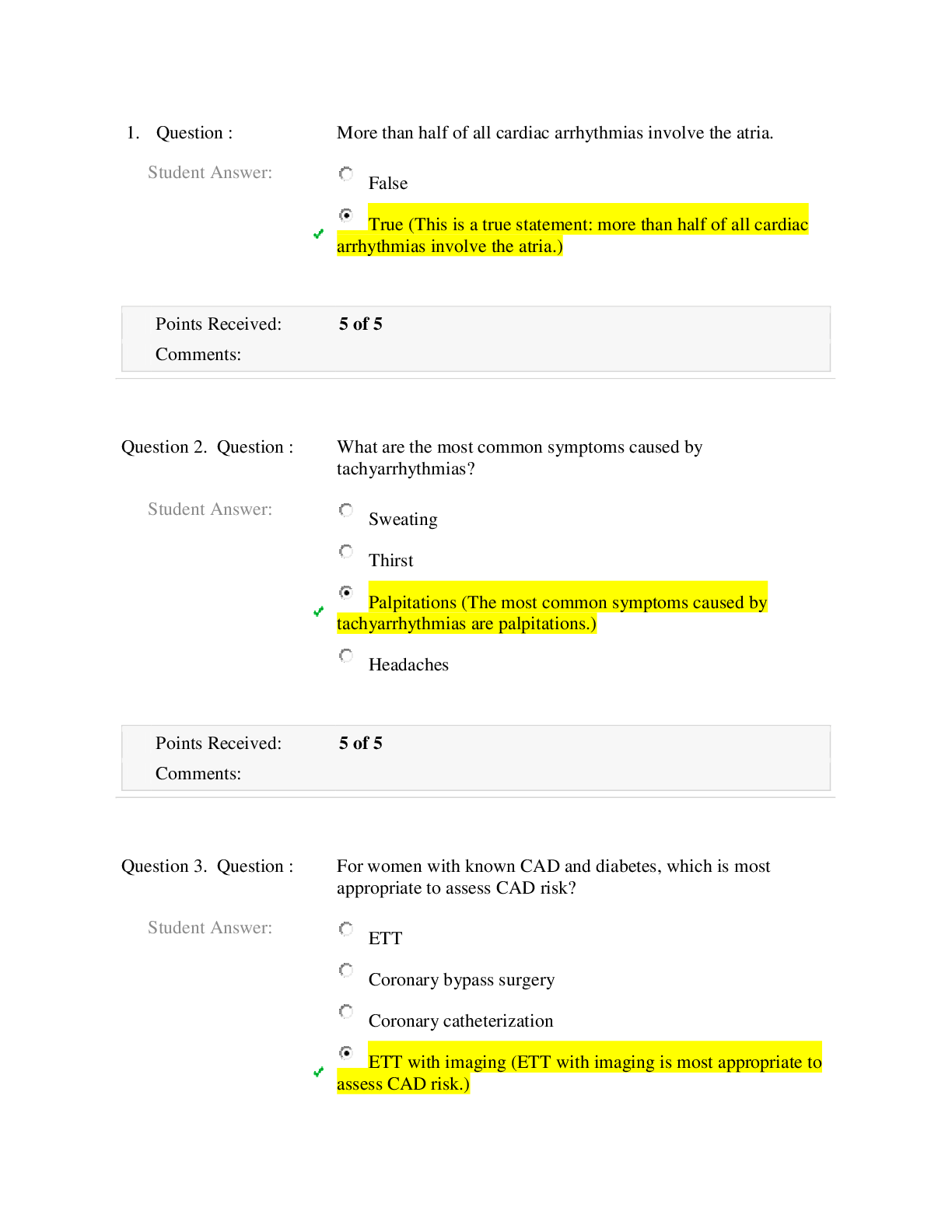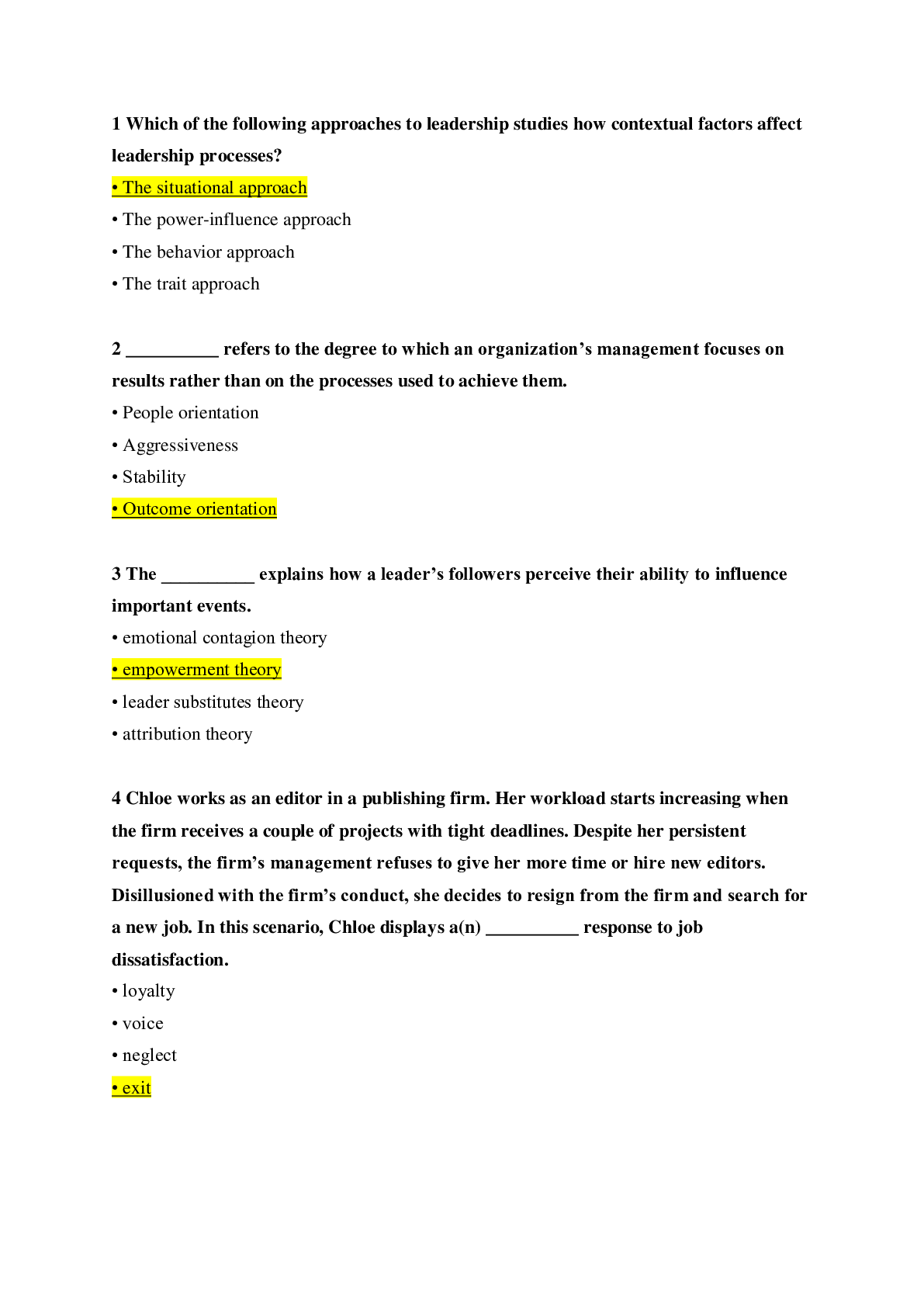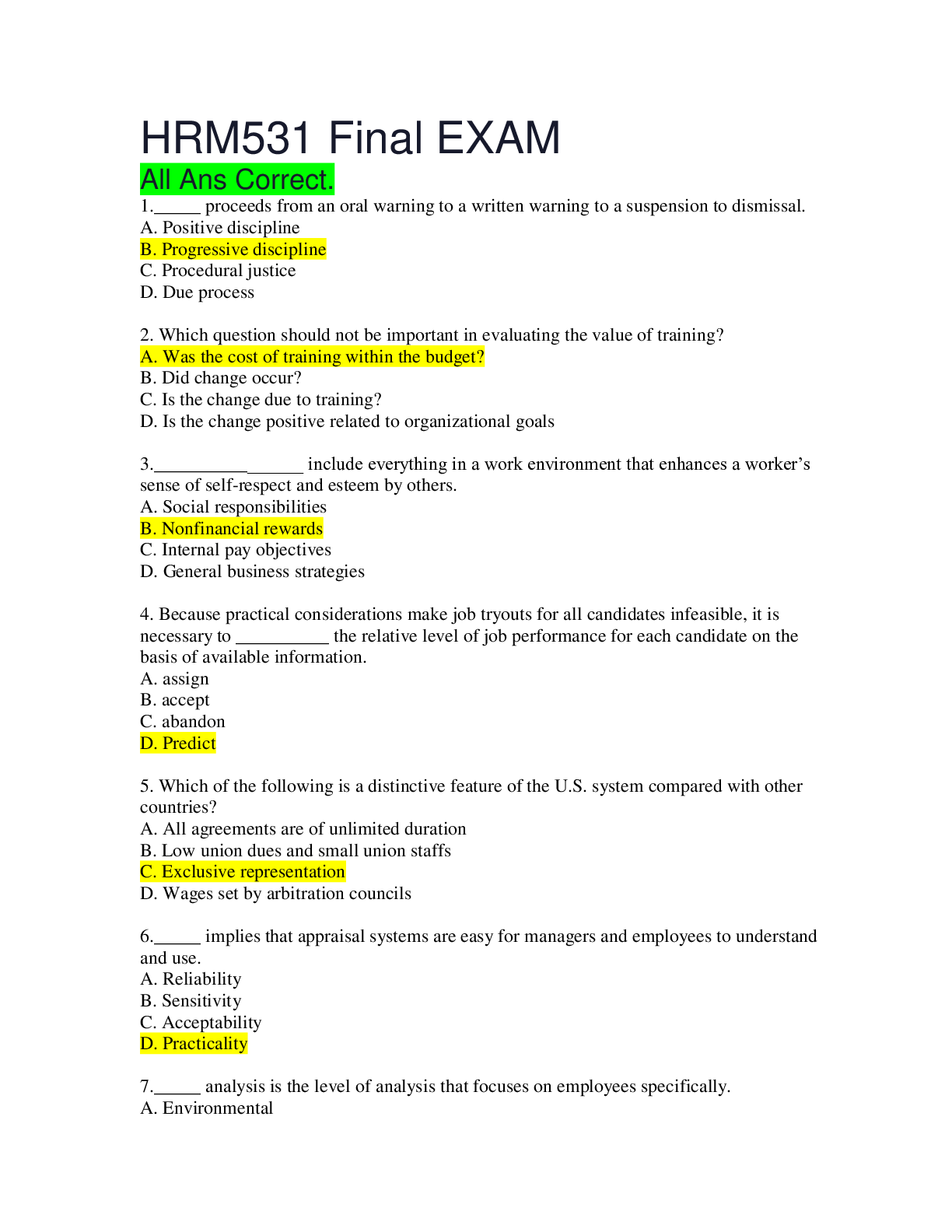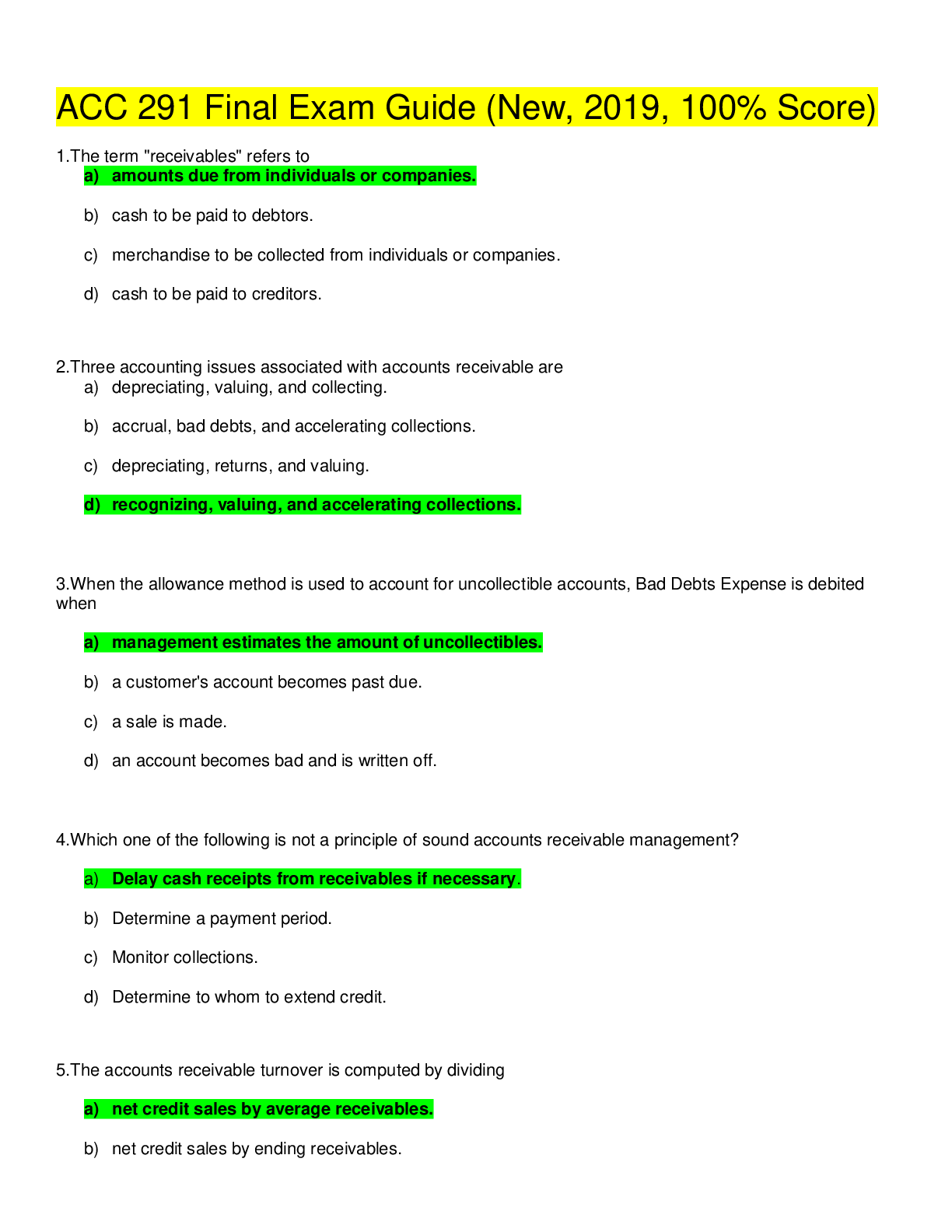NUR 2356/MDC 1 Final Exam Review_ LATEST 2021/2022,100% CORRECT
Document Content and Description Below
NUR 2356/MDC 1 Final Exam Review_ LATEST 2021/2022 Managing open fractures, how to prevent infection Frequent dressing changes with aseptic technique, monitor temperature and heart rate, administe... r broad spectrum antibiotics as ordered (Clindamycin and Gentamycin), irrigate open wound (clean to dirty) Managing ambulation with client who has cancer ➤Ask the patient to wear nonskid footwear. > Place the bed in low position and lock the wheels. > Assist the patient to dangle at the side of the bed > If two nurses are available, each nurse should stand facing the patient on opposite sides of the patient. > Brace your feet and knees against the patient. Bend your hips at the knees and hold onto the transfer belt. Pay attention to any known weakness. > Instruct the patient to place her arms around you between your shoulders and waist (the location depends on the height of the patient and the nurses).Ask the patient to stand as you move to an upright position by straightening your legs and hips. > Allow the patient to steady herself for a moment. > One nurse: Stand at the patient’s side, placing both hands on the transfer belt. If the patient has weakness on one side, position yourself on the weaker side Slowly guide the patient forward. Observe for signs of fatigue or dizziness. > If the patient must transport an IV pole, allow the patient to hold onto the pole on the side where you are standing. Assist the patient to advance the pole as you ambulate OA/RA OA: Degenerative condition. Wear and tear. Loss/wear down of articular cartilage in the joint which causes pain, stiffness, and crepitus (cracking/popping sound). Aggravates with weight- bearing joint use (weight loss, physical exercise, ice) RA: Chronic, inflammatory, autoimmune disorder that causes bone erosion, joint deformity, and painful swelling. Aggravates with weight-bearing joint use. Inflammation and pain with no activity. Ice and heat. Adequate rest. NSAID’s. Stretching. Knee pain assessment Client history, knee inspection for joint effusion/swelling/warmth/deformity, palpate for point tenderness, AROM/PROM, neurovascular assessment Discharge instructions for osteomyelitis Importance of medication adherence and taking full-course, signs/symptoms/re-infection detection, importance of hand hygiene, proper irrigation techniques, assistive device use, assistance with ADL’s Total knee repair management DVT/PE prevention/monitoring (TED hoses, anti-embolic/anti-thrombotic stockings) , surgical dressing changes and monitoring of incision site for infection, observation of mobility and sensation, ABC’s, no excessive blood/fluid loss, monitor tissue perfusion 90 degree ROM- elbow Assessment for patient on bedrest w/pain in leg PROM, neurovascular assessment for DVT/PE, pain assessment Importance of ROM Improves joint function, balance and muscle strength, flexibility, reduces pain and stiffness, improves circulation, reduces injury potential Abduction/adduction AB: away from ADD: towards the body Type of order from provider for acute flank pain Possible reasons for pain: dehydration, kidney problems (kidney stones), UTI Orders: WILDA assessment, blood tests, ultrasound, x-ray, abdominal CT scan, urinalysis/culture, cystoscopy, IV fluids, pain medication ADL limitations for client with limited motion of hands Eating, toileting, bathing, dressing, personal hygiene, weight-bearing activities, medication adherence Priorities for immobility Perform PROM, reposition every 2 hours, encourage independent activity as possible even in bed rest/AROM, provide assistance devices as needed Potential impacts of stress on arthritis Exacerbates symptoms, increases pain and muscle tension, increases risk for development of inflammatory arthritis Response to client reporting fatigue and joint pain Encourage rest, complete pain assessment (WILDA), complete assessment/inspection/medical history, assess ROM Halo traction: pin site red and inflamed Treat with daily pin care, increase dressing changes, culture as needed if pus presents, determine pain level Response to confused client climbing out of bed Move client to room closer to nurses station, implement use of bed alarm, refrain from raising bed rails First action when client falls: check vital signs and for any injuries sustained Priorities for new femur fracture BKA symptoms: phantom pain, decreased ROM, localized swelling Colors of drainage and meaning Serous: watery consistency, clear Sanguineous: bloody drainage, red Serosanguineous: combination of blood and clear serum, pink/blood tinged Purulent: thick, malodorous, pus, yellow, green Priorities for homeless client Physiologic needs and safety needs met, case management/social worker collaboration How to avoid shearing injuries Position bed to 30 degrees or below, use assistive devices when repositioning Narcolepsy management Regular sleep schedule, planned short naps, sleep-inducing environment/hygiene, wake promoting medications, antidepressants Wound healing stages Hemostasis: clotting Inflammatory phase: cleaning/phagocytosis Proliferative phase: granulation/regeneration/fibroblasts form collagen Maturation phase: epithelialization/remodeling/scar tissue/collagen broken down into organized structures/healing Potential harms from low platelet count: thrombocytopenia Cannot form clots, delayed wound healing, severe bleeding, higher risk for infections How to prevent heel skin breakdown Elevate heels using pillows, pressure redistributing devices, reposition every 2 hours Extensive burn assessment ABC’s, inspection (wound drainage, depth of burn injury, wound complications) culture/biopsy/wood’s light exam/diascopy, pain, wound care FRO M H EAD TO TO E CO LO R, TEM PER ATU RE, M O ISTU RE LESIO N S ED EM A VASC U LAR CH A N G ES CLEA N LIN ESS M ED ICATIO N S LIFESTYLE Priority action for oozing wound Inspect/assess wound, get culture if needed, apply pressure and cover wound, implement contact precautions Potential skin outcomes of continuous high-fowler position Increases sacral pressure, increases risk for pressure ulcers and venous stasis in lower extremities, increases risk for skin tears due to shearing forces Role malnourishment plays in skin integrity: disturbs/delays cell metabolism and wound healing, increases infection rate, proteins/fat/water promote tissue integrity and prevent breakdown How to document coccyx wound w/ eschar Stage IV pressure ulcer Priority action for well approximated wound w/ blood tinged drainage D EB R ID EM E N T IN FEC TIO N PA C K D EA D SPA C E A B SO R B E X U D ATE M A IN TA IN M O IST E N V IRO N M E N T O P E N O R C LO SE D W O U N D E D G ES (E P IB O LY ) P RO T EC T FR O M TR A U M A IN SU LAT E Management of abdominal incision with bowel protrusion Immediately cover bowel protrusion with sterile towels/dressings soaked in sterile saline solution, notify surgeon, prepare client for surgery When to culture wounds: prior to cleaning wound Characteristics of client at risk for skin breakdown Advanced age, radiation history, malnourished, immobile, impaired sensation/circulation, long- term steroid use, obese, dermatitis/skin condition history Priority for blanching erythema (reddened skin area that becomes white/pale) in child client ABC’s, determining pulse, relieving pressure to area (repositioning client/increasing activity level), pain level, establishing/maintaining fluid balance Types of activities to delegate to unlicensed assistive personnel relating to client w/ recent tympanoplasty Positioning bed to flat position, taking and recording vital signs, assistance with ADL’s, maintaining a safe environment for the client Glaucoma types, irreversibility education Increased intraocular pressure and progressive/gradual vision loss Risk factors: over age 40, diabetes, hypertension, family history Primary open-angle glaucoma: gradual loss of peripheral vision (tunnel vision), painless, decreased visual acuity, eventual blindness Secondary: related to another eye problem Associated: related to another disease process Meniere’s disease Dizziness/Vertigo/Tinnitus/Hearing Loss Results from abnormal fluid and ion homeostasis in the inner ear Managed with diuretics and salt restriction Fire safety R.A.C.E Which ophthalmology client would be seen first? Primary angle-closure glaucoma, acute onset: MEDICAL EMERGENCY Fibromyalgia symptom reduction Setting sleep schedule, frequent rest, regular exercise (walking, swimming, stretching, yoga), massage therapy, warm moist heat, OTC pain relievers (aspirin, ibuprofen, naproxen sodium), antidepressants, anticonvulsants (Lyrica), vitamin D Impact of ice on oral temperature: lowers/inaccurate reading, wait at least 15-30 minutes to take Lupus Systemic lupus erythematosus: progressive inflammatory connective tissue disorder that causes major body organs and systems to fail, remissions and exacerbations, alopecia, mouth ulcers, polyarthritis Discoid lupus erythematosus: affects only the skin Infant safety Lay on back in crib with nothing else in crib, do not microwave bottles, car seat should be rear facing Dirty needle exposure priorities Hand hygiene, take precautions/complete lab tests, complete incident report Scleroderma assessment findings and education for client w/ scleroderma and recent lung transplant Scleroderma: chronic hardening of skin and connective tissues as a result of excess collagen production. Can affect internal organs including: lungs, GI tract, heart, and kidneys. Symptoms include: tightening of skin, joint pain, Raynaud’s disease (exaggerated response to cold), and heartburn. Pulmonary arterial hypertension (PAH), which sometimes results from scleroderma, is usually treated with medications; however, if not responding to medical therapy lung transplant may be done. Education: aspiration prevention (speech therapist), observation for transplant rejection, lifestyle modifications including eating at least 3 hours prior to sleep and sleeping on medi- wedge, medication adherence (proton-pump inhibitors) Safest position for client at risk for falls: lowest possible position Lab tests ordered for systemic lupus Same as RA: rheumatoid factor, ANA, serum complement, erythrocyte sedimentation rate, SPEP, globulin (alpha 1, alpha 2, beta, gamma), HLA testing, CBC, Anti (ss-a, ss-b, smith, DNA) Raynaud’s disease Rare disorder of the blood vessels, usually in the fingers and toes. It causes the blood vessels to narrow when you are cold or feeling stressed. When this happens, blood can't get to the surface of the skin and the affected areas turn white/blue Proper transferring of client from bed to wheelchair/vice versa Explain the steps to the patient. Park the wheelchair next to the bed, close to you. Put the brakes on and move the footrests out of the way. To get the patient into a seated position, roll the patient onto the same side as the wheelchair. Put one of your arms under the patient's shoulders and one behind the knees. Bend your knees. Swing the patient's feet off the edge of the bed and use the momentum to help the patient into a sitting position. Move the patient to the edge of the bed and lower the bed so the patient's feet are touching the ground. Place the patient's outside leg (the one farthest from the wheelchair) between your knees for support. Bend your knees and keep your back straight. Count to three and slowly stand up. Use your legs to lift. At the same time, the patient should place their hands by their sides and help push off the bed. The patient should help support their weight on their good leg during the transfer. Pivot towards the wheelchair, moving your feet so your back is aligned with your hips. Once the patient's legs are touching the seat of the wheelchair, bend your knees to lower the patient into the seat. At the same time, ask the patient to reach for the wheelchair armrest. Hospital acquired pneumonia known as: Nosocomial pneumonia, ventilator-associated pneumonia Christian scientist beliefs: use proper nutrition, alcohol/tobacco/caffeine avoidance, and adequate rest/sleep to prevent illness, typically refrain from using western medicine, typically do not vaccinate/immunize/accept blood transfusions unless required by law Infection control process for TB Airborne precautions, N95 respirator, negative-pressure room Meaning of virulent: power/ability of agent to cause disease PCP meaning and diagnosis Pneumocystis pneumonia: causes inflammation and fluid build-up in the lungs, often associated with a weakened immune system/HIV, diagnosed through sputum sample or bronchoalveolar lavage collection sample, lung tissue biopsy, blood test to detect PCR Infant immunity Does not fully develop for 2-3 months, breastmilk: passive immunity, vaccines: active immunity Precautions for kidney transplant client Isolation precautions, positive air pressure room, N95 mask when leaving room with construction in area Education for client with HIV Pain management, important of nutrition to prevent malnutrition, drug therapy adherence, infection prevention and being aware of signs/symptoms (avoid crowds, bathe daily with antimicrobial soap, avoid raw fruits/veggies, avoid gardening, hand hygiene), encourage coughing/deep breathing/suctioning, skin integrity promotion/lesion prevention, no alcohol/caffeine/spicy/fatty/sweet foods to prevent diarrhea, seizure precautions, psychosocial distress prevention, interventions to maintain quality of life Catholic beliefs: last rites Hindu beliefs: self-care, showering as opposed to bathing, vegetarians Jehovah Witness: no blood transfusions MRSA protection/precautions/proper PPE: contact precaution, gown and gloves Limited English speaking clients and how to deliver effective care: interpreter service [Show More]
Last updated: 1 year ago
Preview 1 out of 16 pages
Instant download

Buy this document to get the full access instantly
Instant Download Access after purchase
Add to cartInstant download
Reviews( 0 )
Document information
Connected school, study & course
About the document
Uploaded On
Mar 04, 2022
Number of pages
16
Written in
Additional information
This document has been written for:
Uploaded
Mar 04, 2022
Downloads
0
Views
25
















